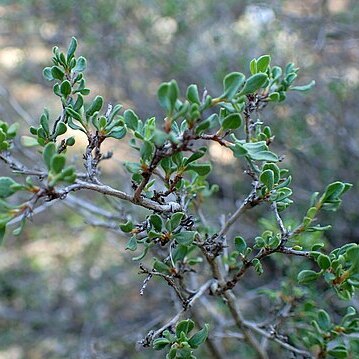Shrubs 30-100 cm tall. Stem slender, with gray scabrous bark; woody branches slender, without leaves at ends, spine-pointed; herbaceous branchlets of current year soon becoming lignified, straight or slightly flexuous, slender, glabrous. Leaves gray-green or blue-green, orbicular, elliptic, broadly elliptic, or broadly ovate, rarely obovate, 3-7 × 3-5 mm, leathery, both surfaces glabrous, reticulate veins raised abaxially, base rounded or cuneate, gradually narrowing into a short petiole, margin entire or slightly undulate, apex rounded or obtuse, short acuminate; ocrea brown at base, cylindric, 2-3 mm, membranous and inconspicuously veined in upper part, cleft into 2 aristate teeth. Pedicel ca. 5 mm, jointed at middle or slightly below. Flowers 2-6 at leaf axil of current year’s branchlets. Tepals pink; outer tepals reflexed in fruit, oblong-ovate or ovate, 2-3 mm. Achenes compressed, light brown, shiny, ovoid or broadly ovoid, smooth, base rounded, apex acuminate or obtuse. Fl. and fr. May-Sep.
More
A shrub. It grows up to 1 m high. The stems are slender. The woody branches are slender and without leaves at the end. There is a spine at the point. The leaves are grey-green are round or oval. They are 3-7 mm long by 3-5 mm wide. They are leathery. There are 2-6 flowers in the axils of current year's growth.
Desert, clayey or gravelly steppes, sandhills and stony slopes. Slopes, deserts (including the Gobi), roadsides, margins of cultivated land; at elevations from 400-1,800 metres in northern China.
More
It is a temperate plant. It grows in deserts. It grows between 400-1,800 m above sea level in northern China.

